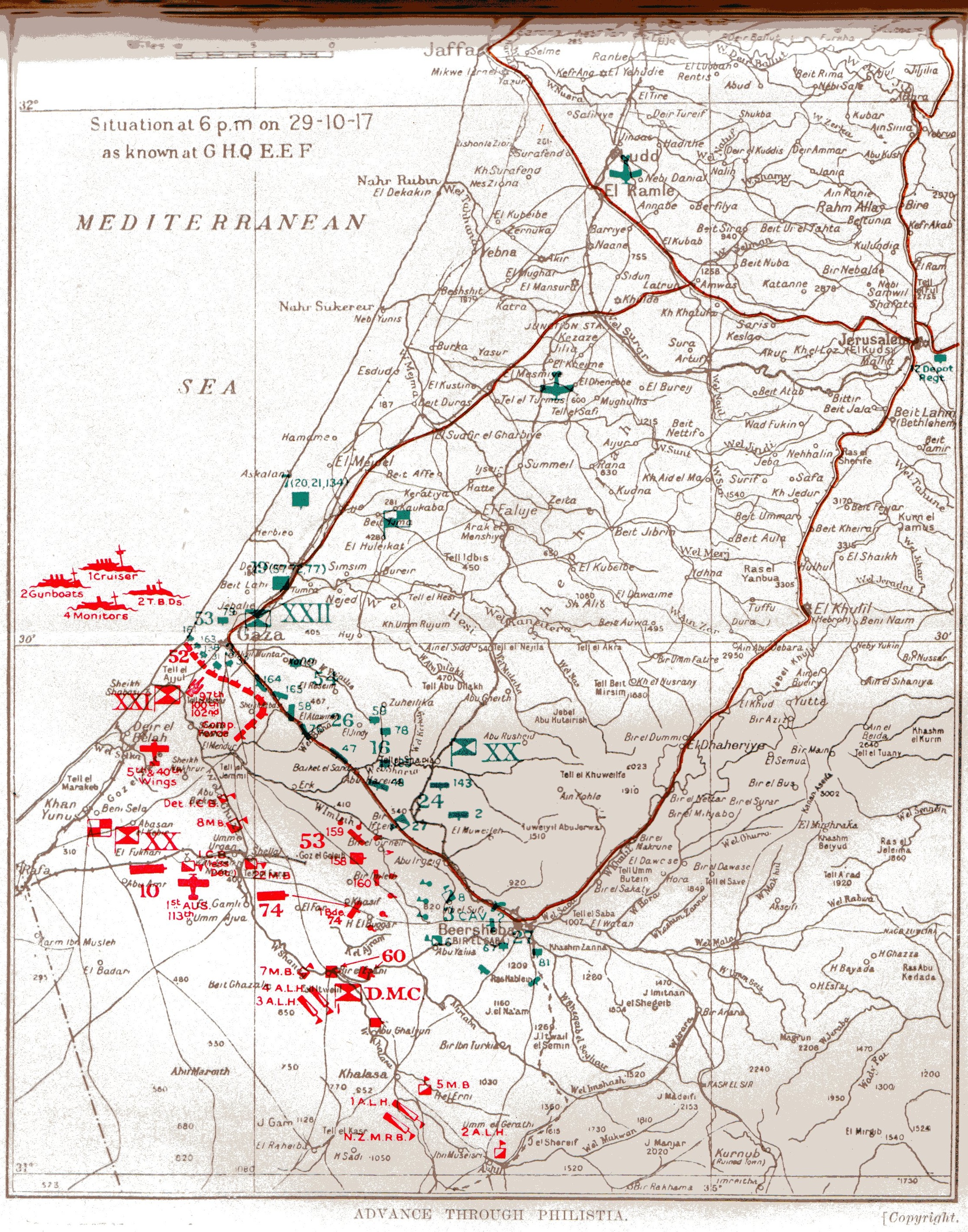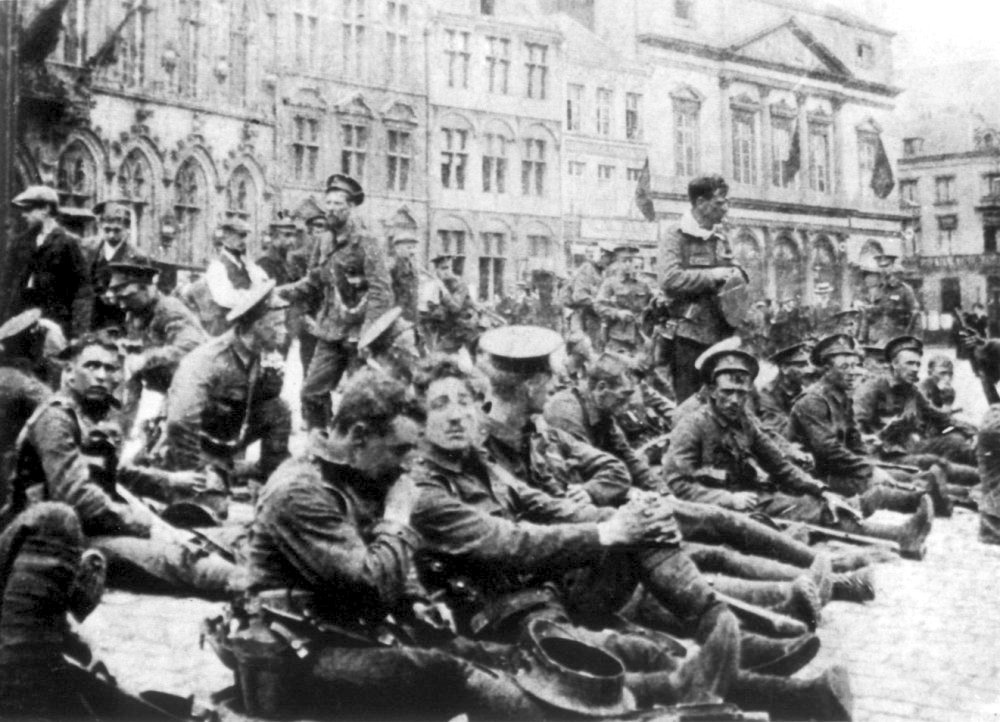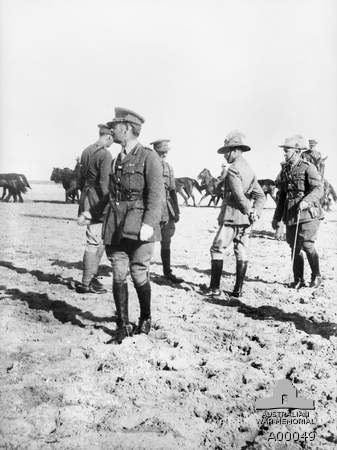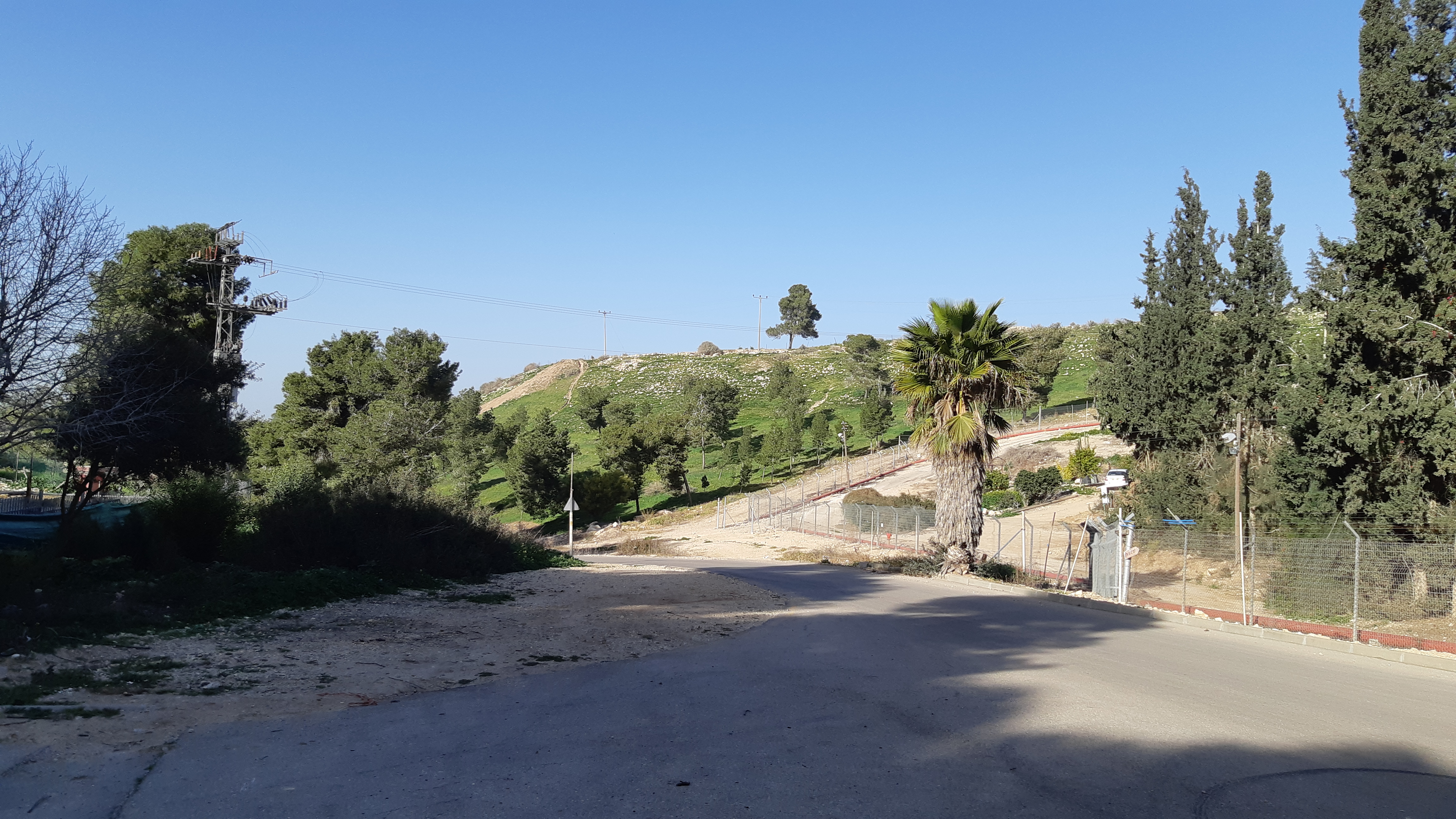|
Third Battle Of Gaza
The Third Battle of Gaza was fought on the night of 1–2 November 1917 between British and Ottoman forces during the Sinai and Palestine Campaign of World War I and came after the British Egyptian Expeditionary Force (EEF) victory at the Battle of Beersheba had ended the Stalemate in Southern Palestine. The fighting occurred at the beginning of the Southern Palestine Offensive, and, together with attacks on Hareira and Sheria on 6–7 November and the continuing Battle of Tel el Khuweilfe, which had been launched by General Edmund Allenby on 1 November, it eventually broke the Gaza-to-Beersheba line defended by the Yildirim Army Group. Despite having held this line since March 1917, the Ottoman Army was forced to evacuate Gaza and Tel el Khuweilfe during the night of 6–7 November. Only Sheria held out for most of 7 November before it too was captured.The several battles fought for the Gaza to Beersheba line between 31 October and 7 November were all assigned the title ... [...More Info...] [...Related Items...] OR: [Wikipedia] [Google] [Baidu] |
Middle Eastern Theatre Of World War I
The Middle Eastern theatre of World War I saw action between 30 October 1914 and 30 October 1918. The combatants were, on one side, the Ottoman Empire, with some assistance from the other Central Powers; and on the other side, the British Empire, British (with the help of Nili, a small number of Jews, Greeks, Armenians, some Kurdish tribes and Arab states, along with British Raj, Hindu, Sikh and Muslim colonial troops from India) as well as troops from the British Dominions of Australia, Canada, and New Zealand, the Russian Empire, Russians (with the help of Armenians, Assyrians, and occasionally some Kurdish tribes), and the French Third Republic, French (with its French North Africa, North African and French West Africa, West African Muslim, Christian and Traditional African religions, other colonial troops) from among the Allies of World War I, Allied Powers. There were five main campaigns: the Sinai and Palestine campaign, Sinai and Palestine, Mesopotamian campaign, Mesopo ... [...More Info...] [...Related Items...] OR: [Wikipedia] [Google] [Baidu] |
Battle Of Beersheba (1917)
The Battle of Beersheba (, )The several battles fought for the Gaza to Beersheba line between 31 October and 7 November were all assigned the title Third Battle of Gaza, although they took place many miles apart, and were fought by different corps. [Battles Nomenclature Committee 1922 p. 32, Falls 1930 Vol. 2 Sketch Maps 1–9] was fought on 31 October 1917, when the British Empire's Egyptian Expeditionary Force (EEF) attacked and captured the Ottoman Empire's Yildirim Army Group garrison at Beersheba, beginning the Southern Palestine Offensive of the Sinai and Palestine campaign of World War I. Overview On 31 October 1917, infantry from the 60th (2/2nd London) Division, 60th (London) and the 74th (Yeomanry) Divisions of the XX Corps (United Kingdom), XX Corps from the southwest conducted limited attacks in the morning, then the Anzac Mounted Division (Desert Mounted Corps) launched a series of attacks against the strong defences, which dominated the eastern side of Beersheba, ... [...More Info...] [...Related Items...] OR: [Wikipedia] [Google] [Baidu] |
Battle Of Passchendaele
The Third Battle of Ypres (; ; ), also known as the Battle of Passchendaele ( ), was a campaign of the First World War, fought by the Allies of World War I, Allies against the German Empire. The battle took place on the Western Front (World War I), Western Front, from July to November 1917, for control of the ridges south and east of the Belgian city of Ypres in West Flanders, as part of a strategy decided by the Entente at conferences in November 1916 and May 1917. Passendale, Passchendaele lies on the last ridge east of Ypres, from Roulers (now Roeselare), a junction of the Bruges-(Brugge)-to-Kortrijk railway. The station at Roulers was on the main supply route of the German 4th Army (German Empire), 4th Army. Once Passchendaele Ridge had been captured, the Allied advance was to continue to a line from Thourout (now Torhout) to Couckelaere (Koekelare). Further operations and a British supporting attack along the Belgian coast from Nieuport (Nieuwpoort, Belgium, Nieuwpoort), ... [...More Info...] [...Related Items...] OR: [Wikipedia] [Google] [Baidu] |
Fourth Army (Ottoman Empire)
The Fourth Army of the Ottoman Empire ( Turkish: ''Dördüncü Ordu'') was one of the field armies of the Ottoman Army. It was formed in the middle nineteenth century, during Ottoman military reforms. The army did not survive the WWI battles in Palestine and Syria. Formations Order of Battle, 1877 In 1877, it was stationed in Anatolia. It was composed of:Ian Drury, Illustrated by Raffaele Ruggeri, ''The Russo-Turkish War 1877'', Men-at-Arms 277, Ospray Publishing Ltd., Reprinted 1999, , p. 35. *Infantry: Five line regiments and six rifle battalions *Cavalry: Three line regiments *Artillery: One line regiment (12 batteries) *Engineer: One sapper company Order of Battle, 1908 After the Young Turk Revolution and the establishment of the Second Constitutional Era on 3 July 1908, the new government initiated a major military reform. Army headquarters were modernized. The Fourth Army's new operational area was Caucasia and its many troops were scattered along the frontier to keep ... [...More Info...] [...Related Items...] OR: [Wikipedia] [Google] [Baidu] |
Archibald Murray
General Sir Archibald James Murray, (23 April 1860 – 21 January 1945) was a British Army officer who served in the Second Boer War and the First World War. He was chief of staff to the British Expeditionary Force (BEF) in August 1914 but appears to have suffered a physical breakdown in the retreat from Mons, and was required to step down from that position in January 1915. After serving as Deputy Chief of the Imperial General Staff for much of 1915, he was briefly Chief of the Imperial General Staff from September to December 1915. He was subsequently Commander-in-Chief of the Egyptian Expeditionary Force from January 1916 to June 1917, in which role he laid the military foundation for the defeat and destruction of the Ottoman Empire in the Arabian Peninsula and the Levant. Military career Born the son of Charles Murray and his wife Anne Graves, and educated at Cheltenham College and the Royal Military College, Sandhurst, Archibald James Murray was commissioned as a ... [...More Info...] [...Related Items...] OR: [Wikipedia] [Google] [Baidu] |
Ottoman Empire
The Ottoman Empire (), also called the Turkish Empire, was an empire, imperial realm that controlled much of Southeast Europe, West Asia, and North Africa from the 14th to early 20th centuries; it also controlled parts of southeastern Central Europe, between the early 16th and early 18th centuries. The empire emerged from a Anatolian beyliks, ''beylik'', or principality, founded in northwestern Anatolia in by the Turkoman (ethnonym), Turkoman tribal leader Osman I. His successors Ottoman wars in Europe, conquered much of Anatolia and expanded into the Balkans by the mid-14th century, transforming their petty kingdom into a transcontinental empire. The Ottomans ended the Byzantine Empire with the Fall of Constantinople, conquest of Constantinople in 1453 by Mehmed II. With its capital at History of Istanbul#Ottoman Empire, Constantinople (modern-day Istanbul) and control over a significant portion of the Mediterranean Basin, the Ottoman Empire was at the centre of interacti ... [...More Info...] [...Related Items...] OR: [Wikipedia] [Google] [Baidu] |
Philip Chetwode
Field Marshal Philip Walhouse Chetwode, 1st Baron Chetwode, (21 September 1869 – 6 July 1950), was a senior British Army officer. He saw action during the Second Boer War, during which he was present at the Siege of Ladysmith in December 1899. He saw action again during World War I on the Western Front, taking part in the First Battle of Ypres, and then in the Sinai and Palestine campaign during which he led his corps at the First Battle of Gaza in March 1917, at the Battle of Beersheba in October 1917 and the Battle of Jerusalem in November 1917. After the War he held a series of senior military appointments including Adjutant-General to the Forces and then Commander in Chief Aldershot Command. He went on to be Chief of the General Staff in India in 1928 and Commander in Chief in India in 1930 and was much concerned with the modernisation and "Indianisation" of the army in India. Early life and education Born the son of Sir George Chetwode, 6th Baronet, and Alice Jane B ... [...More Info...] [...Related Items...] OR: [Wikipedia] [Google] [Baidu] |
Second Battle Of Gaza
The Second Battle of Gaza was fought on 17–19 April 1917, following the defeat of the Egyptian Expeditionary Force (EEF) at the First Battle of Gaza in March, during the Sinai and Palestine Campaign of the First World War. Gaza was defended by the strongly entrenched Ottoman Army garrison, which had been reinforced after the first battle by substantial forces. They manned the town's defences and a line of strong redoubts which extended eastwards along the road from Gaza to Beersheba. The defenders were attacked by the Eastern Force's three infantry divisions, supported by two mounted divisions, but the strength of the defenders, their entrenchments & supporting artillery decimated the attackers. As a result of the EEF victories at the Battle of Romani, the Battle of Magdhaba, and the Battle of Rafa, fought from August 1916 to January 1917, the EEF had pushed the defeated Ottoman Army eastwards. The EEF reoccupied the Egyptian territory of the Sinai Peninsula and crossed ove ... [...More Info...] [...Related Items...] OR: [Wikipedia] [Google] [Baidu] |
First Battle Of Gaza
The First Battle of Gaza was fought on 26 March 1917 during the first attempt by the Egyptian Expeditionary Force (EEF), which was a British Empire military formation, formed on 10 March 1916 under the command of General Archibald Murray from the Mediterranean Expeditionary Force and the Force in Egypt (1914–15), at the beginning of the Sinai and Palestine Campaign of the First World War. Fighting took place in and around the town of Gaza City, Gaza on the Mediterranean coast when infantry and mounted infantry from the Desert Column, a component of the Eastern Force, attacked the town. Late in the afternoon, on the verge of capturing Gaza, the Desert Column was withdrawn due to concerns about the approaching darkness and large Ottoman reinforcements. This British Empire, British defeat was followed a few weeks later by the even more emphatic defeat of the Eastern Force at the Second Battle of Gaza in April 1917. In August 1916, the EEF victory at Battle of Romani, Romani ended ... [...More Info...] [...Related Items...] OR: [Wikipedia] [Google] [Baidu] |
Tel El Khuweilfe
Tel H̱alif, formerly Tel H̱alifa (, Arabic name: Tel el-Khuweilifeh) is an archaeological site, a mound ( tell) in northern Negev area, west from kibbutz Lahav, Israel. Identification Albrecht Alt suggested that it is the location of the biblical town of Ziklag. Other evidence suggests Rimmon. History Tel Halif was a small town inhabited by Israelites during the Iron Age I. It had a casemate wall and typical pillar-courtyard houses in the 9th–8th centuries BCE. William G. Dever estimates that the town's population was 200 in the 10th century and about 300 in the 9th and 8th centuries BCE. Archaeological evidence uncovered a house destroyed during the 701 BCE Assyrian invasion, and the town saw brief reoccupation in the early 7th century before being abandoned under Persian rule. Rock-cut bench tombs were found nearby, and they represent burial practices typical to the 8th century BCE. Excavations Excavcations around Tel Halif was among the research activities of th ... [...More Info...] [...Related Items...] OR: [Wikipedia] [Google] [Baidu] |
Ottoman Army
The Military of the Ottoman Empire () was the armed forces of the Ottoman Empire. It was founded in 1299 and dissolved in 1922. Army The Military of the Ottoman Empire can be divided in five main periods. The foundation era covers the years between 1300 (Byzantine expedition) and 1453 ( Conquest of Constantinople), the classical period covers the years between 1451 (second enthronement of Sultan Mehmed II) and 1606 ( Peace of Zsitvatorok), the reformation period covers the years between 1606 and 1826 ( Vaka-i Hayriye), the modernisation period covers the years between 1826 and 1858 and decline period covers the years between 1861 (enthronement of Sultan Abdülaziz) and 1918 ( Armistice of Mudros). The Ottoman army is the forerunner of the Turkish Armed Forces. Foundation period (1300–1453) The earliest form of the Ottoman military was a steppe-nomadic cavalry force.Mesut Uyar, Edward J. Erickson, ''A Military History of the Ottomans: From Osman to Atatürk'', Pleager Se ... [...More Info...] [...Related Items...] OR: [Wikipedia] [Google] [Baidu] |
Beersheba
Beersheba ( / ; ), officially Be'er-Sheva, is the largest city in the Negev desert of southern Israel. Often referred to as the "Capital of the Negev", it is the centre of the fourth-most populous metropolitan area in Israel, the eighth-most populous Israeli city with a population of , and the second-largest city in area (after Jerusalem), with a total area of 117,500 dunams (45 mi2 / 117.5 km2). Human habitation near present-day Beersheba dates back to the fourth millennium BC. In the Bible, Beersheba marks the southern boundary of ancient Israel, as mentioned in the phrase " From Dan to Beersheba." Initially assigned to the Tribe of Judah, Beersheba was later reassigned to Simeon. During the monarchic era, it functioned as a royal city but eventually faced destruction at the hands of the Assyrians. The Biblical site of Beersheba is Tel Be'er Sheva, lying some 2.5 miles (4km) distant from the modern city, which was established at the start of the 20th century by ... [...More Info...] [...Related Items...] OR: [Wikipedia] [Google] [Baidu] |









